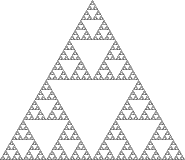
The first of the ten cards in the Rorschach test, with the occurrence of the most statistically frequent details indicated. Credit: Wikimedia Commons.
Rorschach inkblots were once very commonly used by psychologists to assess the personality and mental health of patients. The irregular but symmetrical shapes printed on such inkblots, ten in total, conjure various images from a bat to a woman with a ponytail to a jack-o-lantern. These tests have long gone out of fashion as studies have repeatedly failed to confirm that there’s any strong connection between what people see in the patterns and their personality, creative ability or mental health.
But even now, almost a hundred years since Hermann Rorschach died in 1921 with no idea of how popular and controversial his creation would become, these deceivingly simple inkblots still incite our imagination. Richar Taylor, a physicist at the University of Oregon, has been fascinated by Rorschach inkblots since childhood when he came under the influence of Jackson Pollock, an American abstract expressionist painter. Pollock’s paintings, like Rorschach inkblots, can conjure all kinds of images in the minds of viewers.
Now, Taylor and colleagues have found out what is it that incites our imagination when faced with such abstract images. According to their research, it’s all due to the fractals — irregular geometrical patterns, each part of which has the same statistical character as the whole. Fractals pop up everywhere in nature, from snowflakes to trees to galaxies.

Fractals are infinitely complex patterns that are self-similar across different scales. They are created by repeating a simple process over and over in an ongoing feedback loop. Credit: Fractal Foundation
“These optical illusions seen in inkblots and sometimes in art are important for understanding the human visual system,” said Taylor, who is director of the UO Materials Science Institute. “You learn important things from when our eyes get fooled. Fractal patterns in the inkblots are confusing the visual system. Why do you detect a bat or a butterfly when they were never there?”
Taylor and team dissected the complexity of Rorschach inkblots by first scanning them and then extracting the boundaries between the inked and unstained portions of the cards. A parameter called dimension D quantified the visual complexity of each blot.
The complexity of each blot was then correlated with pattern analysis results from the original studies that used them in the 1930s and 1950s. Strikingly, some of Rorschach’s blots recorded as many as 300 differently perceived images.
The analysis revealed a clear trend between the fractal dimension of each inkblot and the number of perceived images, as reported in the journal PLOS ONE.

Rorschach’s Blot Seven (a). It has fractal signatures made of irregular curves and shapes. According to very old studies, some people see a woman’s head with a ponytail. Image (b) is the same inkblot altered so the fractal borders are removed. Far fewer images could be conjured after this alteration. Credit: Richard Taylor
“As you increase the D value, which makes for more visual complexity, the number of visual perceptions fall off,” he said. “People see a lot more patterns in the simple ones.” Inkblots with D values of 1.1 generate the highest numbers of perceived images, the team found.
Taylor and colleagues tested their findings by enacting an experiment with human subjects. Psychology undergrads were asked to watch computer-generated fractal patterns with varying D values for ten seconds then report what kind of images these reminded them of. The same trend between D values and perceived images was confirmed.
While Rorschach inkblots have fallen in status as a serious psychological tool Taylor says that studying them might help us understand the connection between vision and nature. In 2015 and 2016, Taylor’s University of Oregon lab was awarded a patent and a grant, respectively, for artificial fractal-based implants meant to restore sight to the blind.
“All of our studies are highlighting an effect called fractal fluency,” Taylor said. “The eye has evolved to efficiently process the fractal patterns found in nature’s scenery. This reduces the observer’s stress by up to 60 percent. If you don’t build fractal fluency into a bionic eye, not only have you lost the ability to navigate, you’ve also lost that symbiotic relationship with nature’s fractal patterns.”









